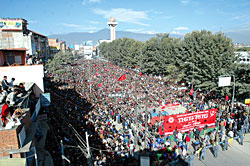For almost four years now, private-sector Nepali newspapers have been headlining photos that show large groups of people attending anti-government rallies in Kathmandu and elsewhere. From the other side of the fence, state-funded media too have been displaying images of large crowds of people turning up to greet the king wherever he goes. In either case, the accompanying reports point to the same conclusion: so many people cannot be wrong. In today's uncertain times in Nepal, showing off the size of one's crowd has become a convenient indicator that's supposed to validate the public strength of one's political position.
But what if such a show of large crowds is actually a wrong indicator of one's democratic strength?
In his book The Wisdom of Crowds, James Surowiecki writes about four criteria that make a crowd's decisions accurate. First, such a crowd has to have a diversity of opinion. 'Each person should have some private information, even if it's just an eccentric interpretation of known facts.' Surowiecki adds that 'diversity contributes not just by adding different perspectives to the group but also by making it easier for individuals to say what they really think.'
The second criterion is independence. This means that 'people's opinions are not determined by the opinions of those around them.' Obviously, a crowd that lets in a variety of opinions, including dissenting ones, is more tolerant of independent voices than one where there's pressure to conform to a groupthink with everyone seeking tepid consensus that 'offends no one rather than
excite everyone.'
The third criterion is decentralisation, which allows for individuals to bring in their specialisation and inject local knowledge into the crowd's deliberations. Aggregation is the fourth criterion. It's a process of adding up all the individual private judgments and then turning them into a collective decision. If a crowd includes these four criteria, Surowiecki says, its judgment is likely to
be accurate.  But what do these criteria mean for our crowd-dependent political processes? It's arguable that of our two groups the one aligned with the political parties is more diverse in terms of opinion. On one level, it is more likely to represent disparate sections of our societies. But the difference ends there. Given that political parties remain rigidly hierarchical entities that do not allow for any independence of thought, it's hard to see how they actually get to derive the benefits of diversity, independence and decentralisation in their ranks.
But what do these criteria mean for our crowd-dependent political processes? It's arguable that of our two groups the one aligned with the political parties is more diverse in terms of opinion. On one level, it is more likely to represent disparate sections of our societies. But the difference ends there. Given that political parties remain rigidly hierarchical entities that do not allow for any independence of thought, it's hard to see how they actually get to derive the benefits of diversity, independence and decentralisation in their ranks.
As a result, for the longest time their protests appeared to have been afternoon programs devised by a few netas to keep themselves busy, not something that really bubbled up to the surface because of the demands placed by diverse sections of the crowd. One danger about such narrow leadership is that by not adequately bringing dissenting views, independent opinions and local knowledge into its decision-making apparatus, it is more likely to reach an extreme but wrong conclusion about the strength of support it actually enjoys in public.
It's time for those who claim that their legitimacy-either on the street or in the corridors of power-comes from the crowd behind them to take another look at that crowd. That way, they'd see for themselves how limited their crowd's composition really is. Maybe then, they'd stop mouthing off the usual platitudes about democracy and start looking for ways to tap into the extant wisdom of the crowd.



